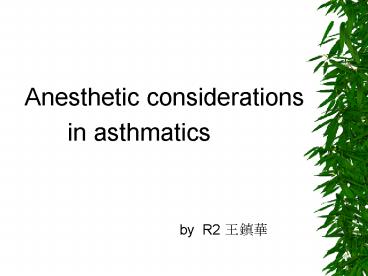Anesthetic considerations - PowerPoint PPT Presentation
1 / 17
Title:
Anesthetic considerations
Description:
Anesthetic considerations in asthmatics by R2 Anesthetic considerations in asthmatics A. Introduction B. Preoperative evaluation C ... – PowerPoint PPT presentation
Number of Views:162
Avg rating:3.0/5.0
Title: Anesthetic considerations
1
- Anesthetic considerations
- in asthmatics
- by R2
???
2
Anesthetic considerations in
asthmatics
- A. Introduction
- B. Preoperative evaluation
- C. Perioperative management
- D. Postoperative management
3
Introduction
- 1. What is the etiology of asthma ?
- the asthmatic diathesis is a nonspecific
- hyperirritability of the
tracheobronchial - tree.
- 2. What are the predisposing factors of
asthmatic attacks ? - Allergens. Pharmacologic stimuli.
- Infections. Exercise. Emotional stress
.
4
Preoperative evaluation
- Frequency and interval of asthmatic
- attacks
- How long would you postpone electi-ve surgery if
the patient had a recent upper respiratory tract
infection? - Cohen MM, Cameron CB. Should you cancel the
operation when a child has an upper respiratory
infection ? Anesth Analg 199172282-288
5
Perioperative management
- 1.How would you induce anesthesia?
- a. Principlesto block airway reflexes before
laryngoscopy and intubation, to relax airway
smooth muscle, and to prevent release of
biochemical mediators. - b. Would you use lidocaine for intubation ?
- c. Would you use propofol , etomidate, or
ketamine for induction instead of pentothal ?
6
- Barash PG, Cullen BF, Stoelting RK, eds. Clinical
anesthesia, - 4th ed. Philadelphia Lippincott Williams
Wilkins, 2001603- - 604.
- Bishop MJ. Bronchospasm successful management.
ASA Ann- - ual Meeting Refresher Course Lectures. Park
Ridge, ILAmeric- - an Society of Anesthesiologists, 2002411
- Martin DE, Rosenberg H, Aukburg 5J, et al.
Low-dose fentanyl blunts circulatory responses to
tracheal intubation. Anesth Analg 198261680. - Eames WO, Rooke GA, et al. Comparison of the
effects of etomidate, propofol, and thiopental on
respiratory resistance following tracheal
intubation. Anesthesiology 1996841307- - 1311
7
- d. Which muscle relaxants would you
- use?
- e. What is your choice of agents for
- maintenance of anesthesia?
8
- Kingston HGG, Hirshman CA. Perioperative
management of the patient with asthma. Anesth
Analg 198463844. - Basta SJ. Modulation of histamine release by
neuromuscular blocking drugs. Curr Opin Anesth
19925572.
9
10
- 2. In the middle of surgery, the patient
developed a severe wheezing attack. How do you
manage it? - a. deepen the level of anesthesia and
- increase FIO2
- b. Relieve mechanical stimulation
- c. Medical intervention is necessary if the
- previously mentioned treatment
- cannot break the bronchospasm
11
- Barnes PJ. A new approach to the treatment of
asthma. N Engl J Med 19893211517-1527. - Bishop MJ. Bronchospasm successful management.
ASA Annual Meeting Refresher Courses. Park Ridge,
IL American Society of Anesthesiologists,
2002411.
12
- 3. How would you administer aminophyl-
- line?How does aminophylline relieve
- bronchospasm?
- The usual intravenous loading dose is
- 6.0 mg/kg given slowly, followed by a
- continuous infusion of 1.0 mg/kg per
- hour for smokers, 0.5 mg/kg per hour
- for nonsmokers .
- It was thought that aminophylline increases
intracellular cAMP through inhibition of the
enzyme phosphodiesterase (PDE), which inactivates
cAMP . - The use of aminophylline in the therapy of
bronchospasm appears to be declining .
13
- Braunwald E, Fauci AS, Kasper DL, et aI, eds,
Harrison's principles of internal medicine, 15th
ed, New York McGraw-Hill, 20011456-1462. - Hirshman CA, Airway reactivity in humans
anesthetic implications. Anesthesiology
198358170.
14
- 4. Would you like to reverse the muscle relaxant
when the operation was completed ?
15
- Gal TJ. Reactive airway disease anesthetic
perspectives. International Anesthesia Research
Society Review Course Lectures. Cleveland, OH
International Anesthesia Research Society,
200245-53.
16
D. Postoperative Management
- 1.Would you extubate the asthmatic patient
while he or she was deeply anesthetized? - 2. When the patient cannot be extubated
immediately following surgery , how would you
keep the endotracheal tube in place without
causing bronchoconstriction? - 3. In asthmatic patients, are narcotics
contraindicated for postoperative pain control?
17
- Lien CAt Kaff H, Malhotra V, et al. Emergence and
extubation a systemic approach. Anesth Analg
1997851177. - Miller KH, Harkin CP Bailey PL. Postoperative
tracheal extubation. Anesth Analg
199580148-172.































